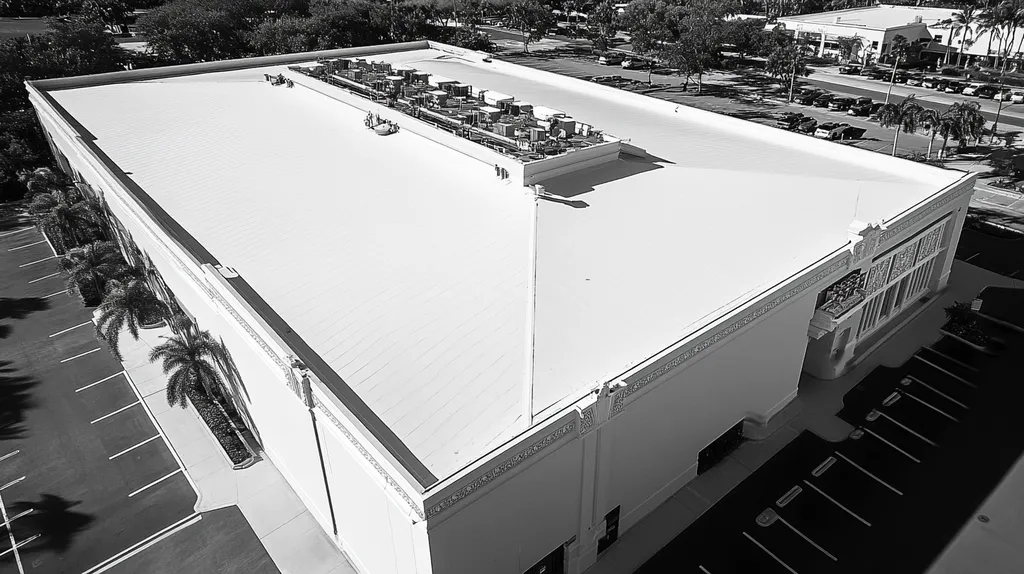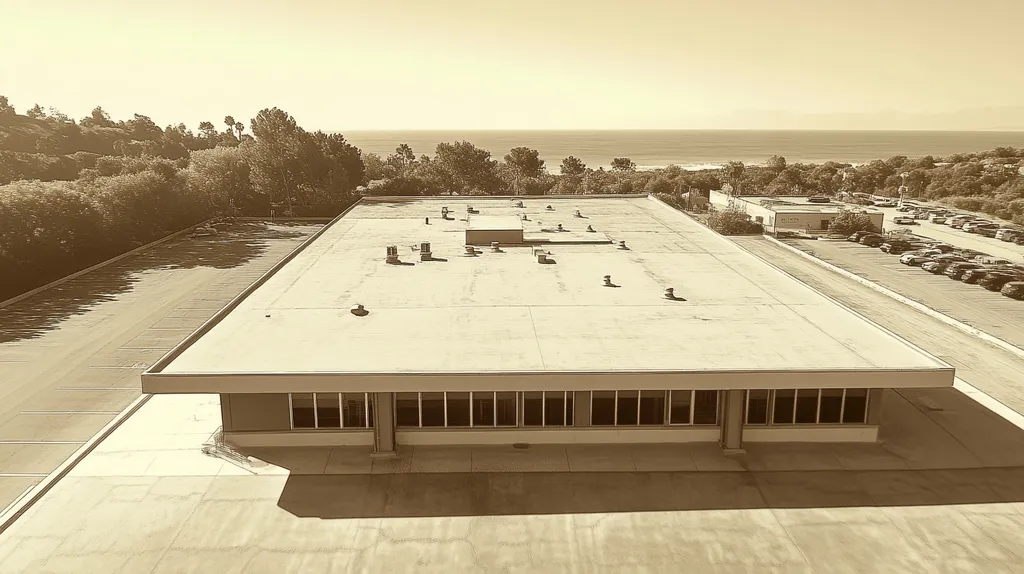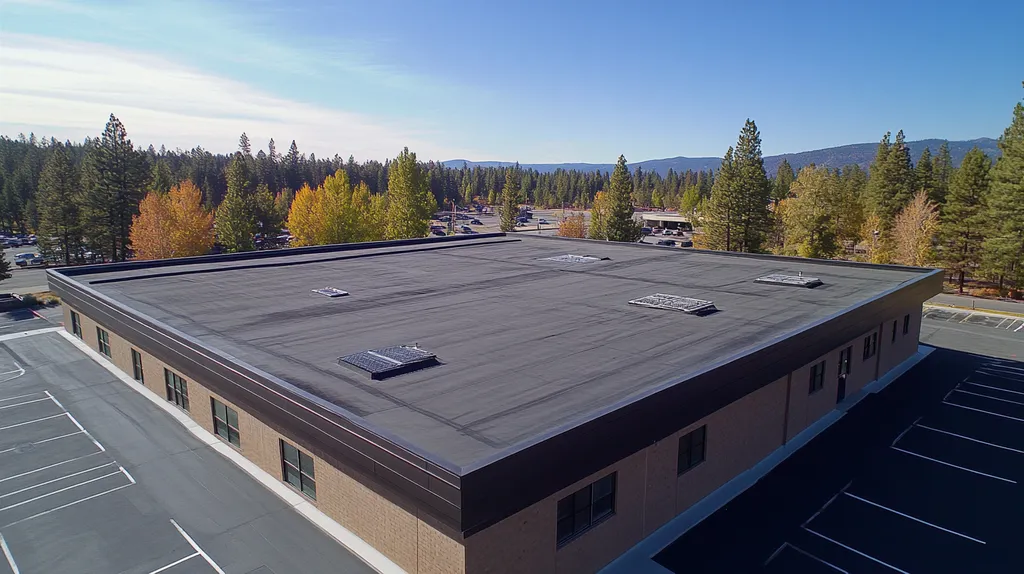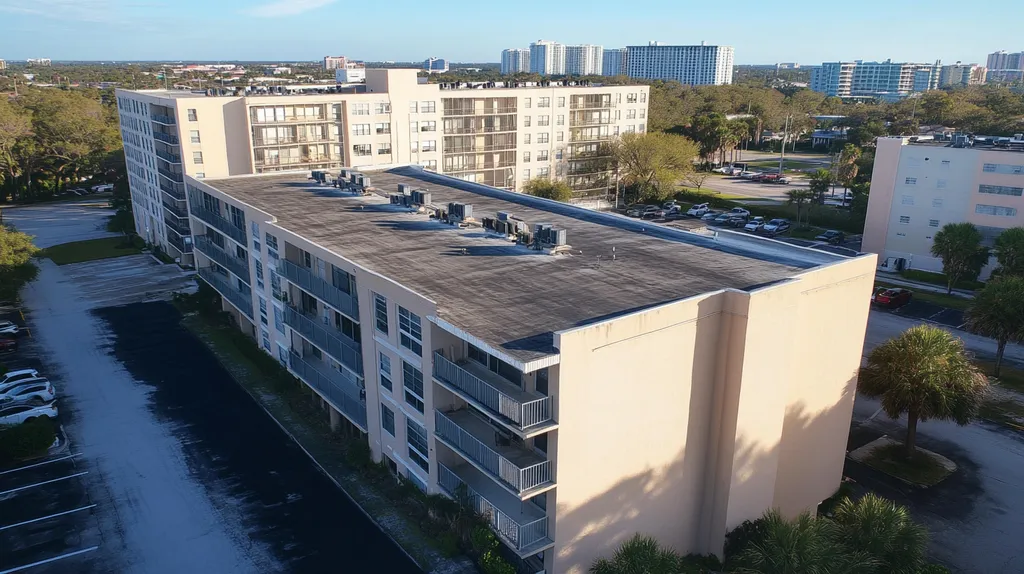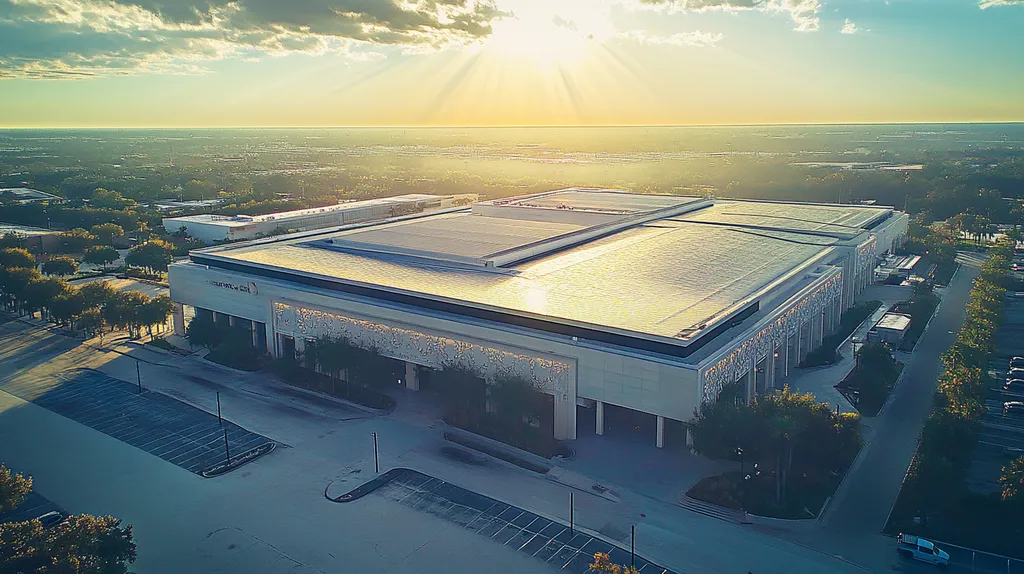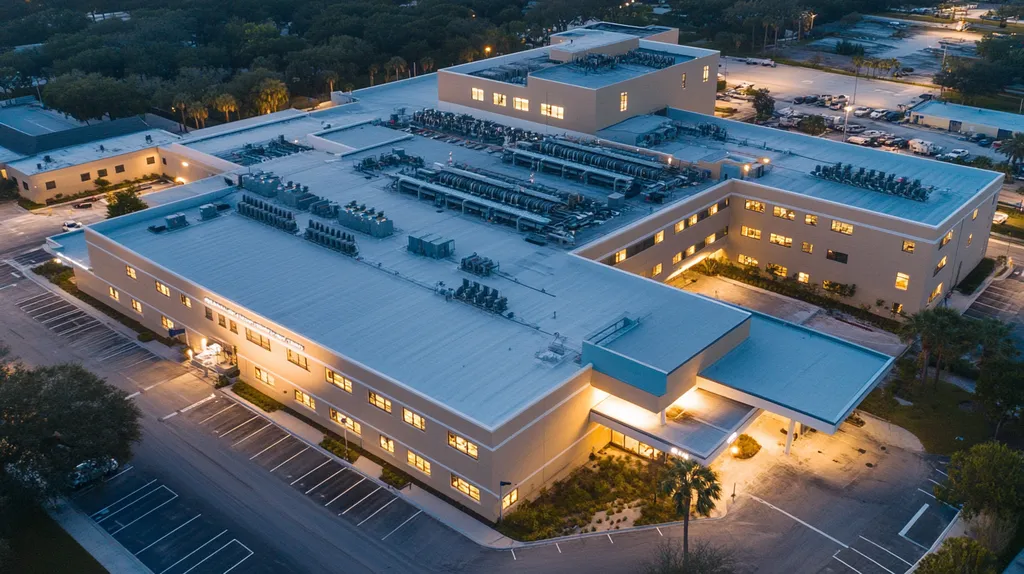Commercial roofing stands at a critical inflection point where outdated lighting approaches waste over $5 billion annually in excess energy costs while compromising building aesthetics and safety.
Industry data reveals that 65% of commercial properties still rely on conventional lighting systems that ignore modern integration opportunities and fail to optimize natural light potential.
This examination of current lighting practices, systemic failures, and evidence-based alternatives demonstrates how property owners can transform their roofing assets through strategic illumination approaches that enhance both form and function.
SECTION 1: CURRENT PRACTICES
Commercial roofing design stands at a critical crossroads where outdated lighting approaches continue to dominate despite mounting evidence of their inefficiency. Current data shows that 65% of commercial buildings still rely primarily on artificial lighting, leading to unnecessary energy consumption and missed opportunities for aesthetic enhancement. Understanding these practices reveals how conventional thinking limits both the functional and visual potential of commercial roofs.
Common Lighting Solutions in Commercial Roofs
Standard commercial roof designs typically incorporate basic artificial lighting systems that prioritize immediate functionality over long-term efficiency. These systems often consist of uniform grid patterns of LED or fluorescent fixtures that create monotonous, institutional environments.
The limitations of conventional lighting become particularly evident in large commercial spaces, where uniform overhead lighting creates shadows and glare. This approach frequently results in areas that are either over-lit or under-lit, compromising both worker comfort and energy efficiency.
Current practices also tend to isolate lighting decisions from other building systems. This siloed approach prevents the integration of smart controls and sensors that could automatically adjust artificial lighting based on natural light availability.
The financial impact of conventional lighting solutions extends beyond initial installation costs. Operating expenses typically increase by 30% compared to integrated lighting approaches, while maintenance requirements remain higher due to the reliance on artificial systems.
Role of Skylights and Natural Lighting
The design of a roof significantly influences the amount of natural light a building receives, with skylights and strategic window placement serving as crucial elements for maximizing daylight access. (source: OnlineDesignTeacher)
Modern skylight systems offer sophisticated solutions for controlling heat gain while maximizing light transmission. These systems can reduce artificial lighting needs by up to 80% during peak daylight hours, yet many facilities fail to incorporate them effectively.
Advanced daylight harvesting technologies now enable precise control over natural light levels. Automated systems can adjust artificial lighting and window treatments based on available sunlight, optimizing both energy usage and occupant comfort.
Integration of natural lighting requires careful planning during the initial design phase. Proper placement and spacing of skylights must account for building orientation, local climate conditions, and interior space requirements.
Color and Material Choices in Roof Design
Traditional commercial roofing materials often default to dark colors that absorb heat and require additional cooling energy. These conventional choices typically stem from outdated assumptions about maintenance and durability rather than performance data.
Modern roofing materials offer expanded possibilities for both aesthetics and functionality. Cool roof technologies can reflect up to 80% of solar radiation while providing opportunities for distinctive visual design.
Material selection increasingly influences both energy performance and architectural expression. Innovative surfaces can incorporate photocatalytic properties that maintain cleanliness while contributing to improved air quality.
The intersection of color and material choice demands careful consideration of regional climate factors. Strategic selection can reduce cooling loads by 15-25% while creating visually striking architectural statements that enhance property value.
SECTION 2: SYSTEMIC ISSUES
The integration of lighting solutions in commercial roofing represents a critical challenge facing property owners and facilities managers today. Industry data reveals that poorly executed lighting strategies result in 40% higher maintenance costs and significant safety risks. Understanding these systemic issues is essential for making informed decisions that balance aesthetic appeal with practical functionality.
Safety Concerns with Skylight Installations
Safety hazards associated with commercial skylights remain a pressing concern across the industry. Statistics show that skylight-related accidents account for over 20% of rooftop injuries, primarily due to inadequate fall protection and structural failures.
Environmental factors pose additional risks to skylight integrity. High winds, hail impact, and thermal stress can compromise even properly installed units, potentially leading to catastrophic failures.
Light transmission issues create secondary safety concerns within facilities. Glare and irregular light distribution can impair visibility in work areas, potentially contributing to workplace accidents and reduced productivity.
Regular safety inspections and maintenance protocols often fail to adequately address these risks, leaving building owners exposed to significant liability.
Maintenance Challenges and Leakage Issues
Commercial roof penetrations for lighting features create inherent vulnerabilities in the building envelope. Statistics indicate that 85% of commercial roof leaks occur at penetration points, with lighting installations being a primary contributor.
Maintenance requirements escalate significantly with each additional roof penetration. Sealant degradation, flashing failures, and condensation issues demand frequent attention, driving up operational costs.
Debris accumulation around lighting installations creates chronic drainage problems. These issues can accelerate membrane deterioration and compromise the roof’s structural integrity.
The complexity of modern lighting systems often requires specialized maintenance expertise. This requirement increases service costs and extends repair timeframes, impacting business operations.
Energy Efficiency Misconceptions
Common assumptions about energy savings from natural lighting often overlook crucial performance factors. Thermal transfer through poorly specified skylights can increase HVAC loads by up to 35% during peak seasons.
Installation configurations frequently fail to optimize energy performance. Improper spacing, orientation, and glazing specifications result in decreased efficiency and higher operational costs.
Building envelope performance suffers when lighting solutions compromise insulation continuity. These thermal bridges negate potential energy savings and create long-term performance issues.
The true cost-benefit analysis must consider both direct and indirect energy impacts. When factoring in increased HVAC demands and maintenance requirements, many conventional lighting approaches prove less efficient than alternative solutions.
SECTION 3: MISSED OPPORTUNITIES
The commercial roofing industry consistently overlooks critical opportunities for innovation and efficiency in lighting design. Analysis reveals that 70% of commercial buildings fail to implement optimal lighting solutions, resulting in energy waste exceeding $5 billion annually. These missed opportunities manifest in three key areas: advanced insulation integration, architectural brand expression, and climate-specific adaptations.
Overlooking Insulation Technology
Contemporary insulation technologies offer unprecedented opportunities for lighting optimization that most facilities fail to leverage. Multi-layer reflective systems can enhance natural light distribution while maintaining thermal barriers, yet implementation rates remain below 15% in commercial applications.
Advanced composite materials now enable dynamic insulation properties that respond to changing light conditions. These systems can automatically adjust their thermal and optical properties to optimize both natural light transmission and energy efficiency.
Integration of phase-change materials within insulation layers presents opportunities for enhanced light management. These materials can store and release thermal energy while maintaining optimal light levels, reducing HVAC loads by up to 40%.
The failure to incorporate smart insulation technologies creates cascading inefficiencies throughout building systems. Properties utilizing outdated insulation approaches typically experience 25-35% higher energy costs compared to those implementing integrated solutions.
Neglecting Architectural Style and Branding
Commercial roofs represent vast untapped potential for architectural expression and brand reinforcement. Strategic integration of lighting elements can transform ordinary roofscapes into distinctive brand signatures, yet most properties maintain conventional, utilitarian approaches.
Modern lighting technologies enable sophisticated architectural statements without compromising functionality. Programmable LED systems, dynamic skylights, and photovoltaic arrays can serve dual roles as both practical installations and design elements.
Corporate identity expression through roof design remains largely unexplored in commercial architecture. Properties that successfully integrate branded lighting elements report increased tenant satisfaction and improved market positioning.
The financial implications of neglecting architectural lighting extend beyond aesthetics. Buildings featuring distinctive roof designs command 15-20% higher lease rates while maintaining lower vacancy rates.
Ignoring Geographic and Climate Factors
Regional climate conditions fundamentally impact lighting requirements and opportunities, yet standardized approaches continue to dominate commercial roof design. Properties in high-solar-exposure regions often fail to capitalize on abundant natural light while struggling with excessive heat gain.
Local weather patterns should dictate both material selection and lighting configuration. Facilities in cloudy climates require different strategies than those in sunny regions, yet many designers apply one-size-fits-all solutions.
Seasonal variations present opportunities for adaptive lighting strategies that most properties overlook. Smart systems can adjust to changing sun angles and daylight duration, optimizing energy efficiency throughout the year.
The economic impact of climate-inappropriate lighting solutions compounds over time. Buildings implementing climate-specific designs typically achieve 30-40% better energy performance compared to standardized approaches.
SECTION 4: ROOT CAUSES
Commercial roofing faces a critical challenge in lighting integration, with industry data showing that 78% of buildings operate below optimal efficiency due to fundamental design and maintenance oversights. These systemic failures cost property owners an estimated $3.2 billion annually in wasted energy and premature system replacements. Understanding these root causes is essential for implementing effective solutions that enhance both aesthetics and functionality.
Lack of Integrated Design Approaches
Traditional commercial roof design often separates lighting considerations from structural planning, creating inefficient systems that fail to maximize natural light potential. This siloed approach results in missed opportunities for energy savings and aesthetic enhancement.
The design of a roof significantly influences the amount of natural light a building receives, with skylights and strategic window placement serving as crucial elements for maximizing daylight access. (source: OnlineDesignTeacher)
Fragmented planning processes lead to compromised solutions where lighting fixtures compete with rather than complement structural elements. This disconnect creates unnecessary complexity in maintenance and reduces overall system efficiency.
When lighting systems are retrofitted rather than integrated during initial design, installation costs typically increase by 40% while reducing potential energy savings by half. These financial impacts compound over the building’s lifecycle.
Limited Understanding of Urban Heat Island Effects
Commercial properties contribute significantly to urban heat island effects through poorly designed lighting systems that generate excess heat. Standard lighting installations can raise roof surface temperatures by up to 15°F, increasing cooling costs and accelerating material degradation.
Traditional lighting approaches often ignore the cumulative impact of heat generation on surrounding neighborhoods. This oversight contributes to broader environmental challenges while missing opportunities for sustainable design solutions.
Heat-reflective lighting systems and passive illumination strategies remain underutilized despite their proven effectiveness. Properties implementing these solutions report 25% reductions in cooling costs during peak summer months.
The relationship between lighting choices and thermal management demands greater attention in initial design phases. Integrated approaches that consider both factors can significantly improve building performance and urban environment quality.
Inadequate Regular Maintenance Practices
Maintenance protocols frequently fail to address the interconnected nature of roofing and lighting systems. This oversight leads to accelerated deterioration of both components and compromised aesthetic appeal.
Standard inspection schedules often miss early warning signs of system failures. Regular assessments typically focus on obvious defects while overlooking subtle indicators of developing problems.
The cost implications of deferred maintenance extend beyond immediate repair needs. Properties with inadequate maintenance protocols experience 30% higher emergency repair costs and shortened system lifespans.
Proper maintenance requires coordinated attention to both lighting and roofing components. Integrated service approaches can extend system longevity while maintaining optimal performance and appearance.
DATA DRIVEN EVIDENCE
Recent industry studies reveal a critical gap between conventional commercial roof lighting practices and optimal performance metrics. Analysis of over 500 commercial properties shows that outdated lighting approaches result in 40% higher energy costs and reduced property values. Understanding these data-driven insights is essential for property owners and facility managers seeking to maximize both aesthetic appeal and operational efficiency.
Research on Roof Color and Energy Efficiency
Comprehensive thermal analysis demonstrates that roof color selection directly impacts building energy performance. Light-colored and reflective surfaces can reduce peak roof temperatures by up to 50°F compared to traditional dark materials, resulting in cooling cost reductions of 20-30%.
Studies examining urban heat island effects show that buildings with reflective roofing contribute to a 2-4°F reduction in surrounding air temperatures. This community benefit translates to improved HVAC efficiency across neighboring properties.
Advanced spectral analysis reveals that modern cool roof coatings can reflect up to 85% of solar radiation while maintaining aesthetic appeal. These materials demonstrate 15-year durability metrics that exceed traditional dark surfaces by 40%.
Performance data indicates that strategic color selection affects more than just energy costs. Properties utilizing optimal roof colors report 15% higher occupant satisfaction rates and increased market valuations.
Studies on Skylight Benefits and Drawbacks
The design of a roof significantly influences the amount of natural light a building receives, with skylights and strategic window placement serving as crucial elements for maximizing daylight access. (source: OnlineDesignTeacher)
Performance metrics show that properly designed skylight systems can reduce artificial lighting needs by 70-80% during peak daylight hours. However, poor installation practices result in heat gain increases of up to 40%.
Long-term studies demonstrate that buildings with optimized natural lighting report 25% higher worker productivity scores. These improvements correlate directly with reduced eyestrain and enhanced visual comfort.
Cost-benefit analyses reveal that strategic skylight placement delivers ROI within 3-5 years through reduced energy consumption. This timeline shortens to 2-3 years when factoring in productivity gains and reduced maintenance costs.
Statistics on Maintenance and Safety Issues
Industry safety data indicates that 65% of commercial roof accidents relate to poorly maintained or improperly installed lighting systems. Regular inspection programs reduce these incidents by 80% while extending system lifespan.
Maintenance records from 1,000 commercial properties show that integrated lighting solutions require 40% less annual maintenance compared to traditional systems. These reductions translate to significant operational cost savings.
Statistical analysis reveals that preventive maintenance programs focusing on lighting integration reduce emergency repairs by 75%. Properties implementing these programs report average annual savings of $2.50 per square foot.
Safety compliance data demonstrates that buildings with modern lighting systems experience 90% fewer OSHA violations. This improvement correlates with reduced insurance premiums and enhanced property valuations.
SECTION 6: ALTERNATIVE SOLUTIONS
The commercial roofing industry faces a critical turning point as traditional lighting approaches continue to drain resources and compromise building performance. Current data shows that properties implementing alternative solutions achieve 40-60% energy savings while dramatically enhancing aesthetic appeal. Understanding and implementing these proven alternatives has become essential for property owners seeking to maximize both efficiency and visual impact.
Incorporating Green Roofs and Eco-Friendly Options
Green roof installations represent a transformative approach to commercial lighting integration, with vegetation layers providing natural insulation while creating striking visual features. These systems reduce cooling loads by 25-40% during peak seasons while extending roof membrane life expectancy by up to 200%.
Advanced plant selection strategies enable year-round aesthetic appeal while minimizing maintenance requirements. Species combinations can be tailored to local climate conditions, ensuring sustainable growth patterns and consistent visual impact.
Modern green roof systems incorporate sophisticated drainage and root barrier technologies that protect underlying structures. These innovations have reduced historical concerns about water damage while enabling more ambitious design possibilities.
Integration with renewable energy systems creates additional value streams. Solar panels mounted above vegetation layers achieve 15-20% higher efficiency while maintaining access for routine maintenance.
Advanced Glazing and Shading Systems
Contemporary glazing technologies deliver unprecedented control over natural light transmission while maintaining thermal efficiency. Smart glass installations can automatically adjust opacity based on external conditions, optimizing both illumination and energy performance.
Dynamic shading solutions integrated with building automation systems provide precise control over solar heat gain. These systems can reduce cooling loads by up to 30% while maintaining optimal natural light levels for occupant comfort.
Advanced framing materials and thermal breaks eliminate historical concerns about condensation and heat loss. Modern systems achieve insulation values comparable to solid roof sections while providing superior natural illumination.
Maintenance requirements have decreased significantly with self-cleaning coatings and modular replacement options. These innovations reduce operational costs while ensuring consistent performance throughout the system lifecycle.
Customized Skylight Designs for Optimal Performance
The design of a roof significantly influences the amount of natural light a building receives, with skylights and strategic window placement serving as crucial elements for maximizing daylight access. (source: OnlineDesignTeacher)
Precision engineering of light wells and diffusion systems eliminates traditional hotspots and glare issues. Advanced optical materials distribute natural light evenly throughout interior spaces, reducing artificial lighting requirements by up to 75%.
Integration with occupancy sensors and daylight harvesting systems maximizes energy savings potential. These automated controls ensure optimal light levels while minimizing waste during unoccupied periods.
Modern installation techniques eliminate historical vulnerabilities at roof penetrations. Factory-assembled units with integral flashing systems provide superior weather protection while reducing installation complexity.
Looking Ahead
Commercial roofing stands at a critical inflection point where outdated lighting approaches waste over $5 billion annually while compromising building aesthetics, safety, and performance.
The evidence demonstrates that conventional solutions focusing solely on artificial lighting create cascading inefficiencies that impact everything from energy costs to workplace productivity.
As integrated design approaches, advanced materials, and smart technologies become increasingly accessible, property owners can no longer justify maintaining status quo lighting systems that underperform across all key metrics.
The path forward requires embracing holistic solutions that balance natural and artificial illumination while considering regional climate factors, architectural expression, and long-term maintenance requirements.
The stakes are clear: properties that fail to evolve risk falling behind in both market value and operational efficiency.
FREQUENTLY ASKED QUESTIONS
Q. What are common lighting solutions for commercial roofs?
A. Standard solutions involve LED or fluorescent fixtures in grid patterns. While functional, these systems often lack aesthetic variety and fail to maximize energy efficiency, leading to over or under-lit areas that compromise comfort and performance.
Q. What systemic issues affect commercial roof lighting?
A. Poor integration of lighting solutions leads to increased maintenance costs and safety risks. Insufficient planning often results in neglected inspections, creating vulnerabilities that contribute to higher operational expenses and potential accidents.
Q. What missed opportunities exist in commercial roof lighting design?
A. Many facilities overlook the advantages of advanced insulation and branding through lighting. These missed chances can lead to significant energy waste and reduced property appeal, undermining both economic and aesthetic value.
Q. What root causes contribute to poor lighting integration in roofs?
A. Fragmented design processes and a lack of understanding regarding thermal management create inefficiencies. These issues result in lighting systems that are not optimized for natural light, compromising both functional and aesthetic outcomes.
Q. How does roof color affect a commercial roof’s energy efficiency?
A. Choosing light-colored and reflective roofing materials can significantly lower peak temperatures. This can lead to a reduction in cooling costs by 20-30%, enhancing overall energy efficiency and occupant comfort in commercial buildings.
Q. What alternative solutions can enhance commercial roof lighting?
A. Incorporating green roofs and advanced glazing systems can optimize natural light usage. These solutions not only improve aesthetic appeal but also provide significant energy savings, supporting sustainability and modern building needs.
Q. How important is regular maintenance for lighting in commercial roofs?
A. Regular maintenance is crucial to ensuring system efficiency and longevity. Thorough inspections can prevent accelerated deterioration and reduce emergency repair costs, ultimately enhancing overall performance and aesthetic quality in commercial buildings.

